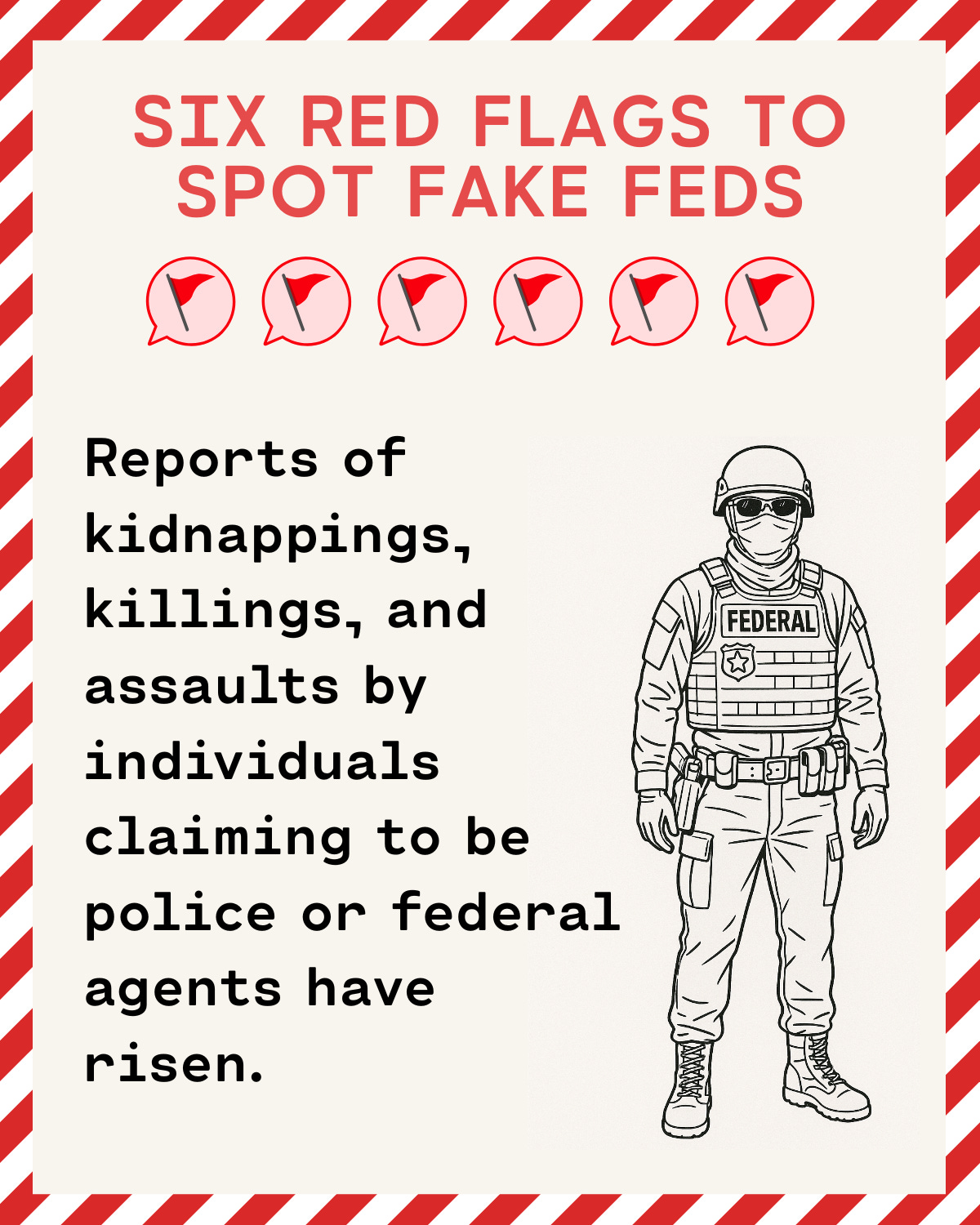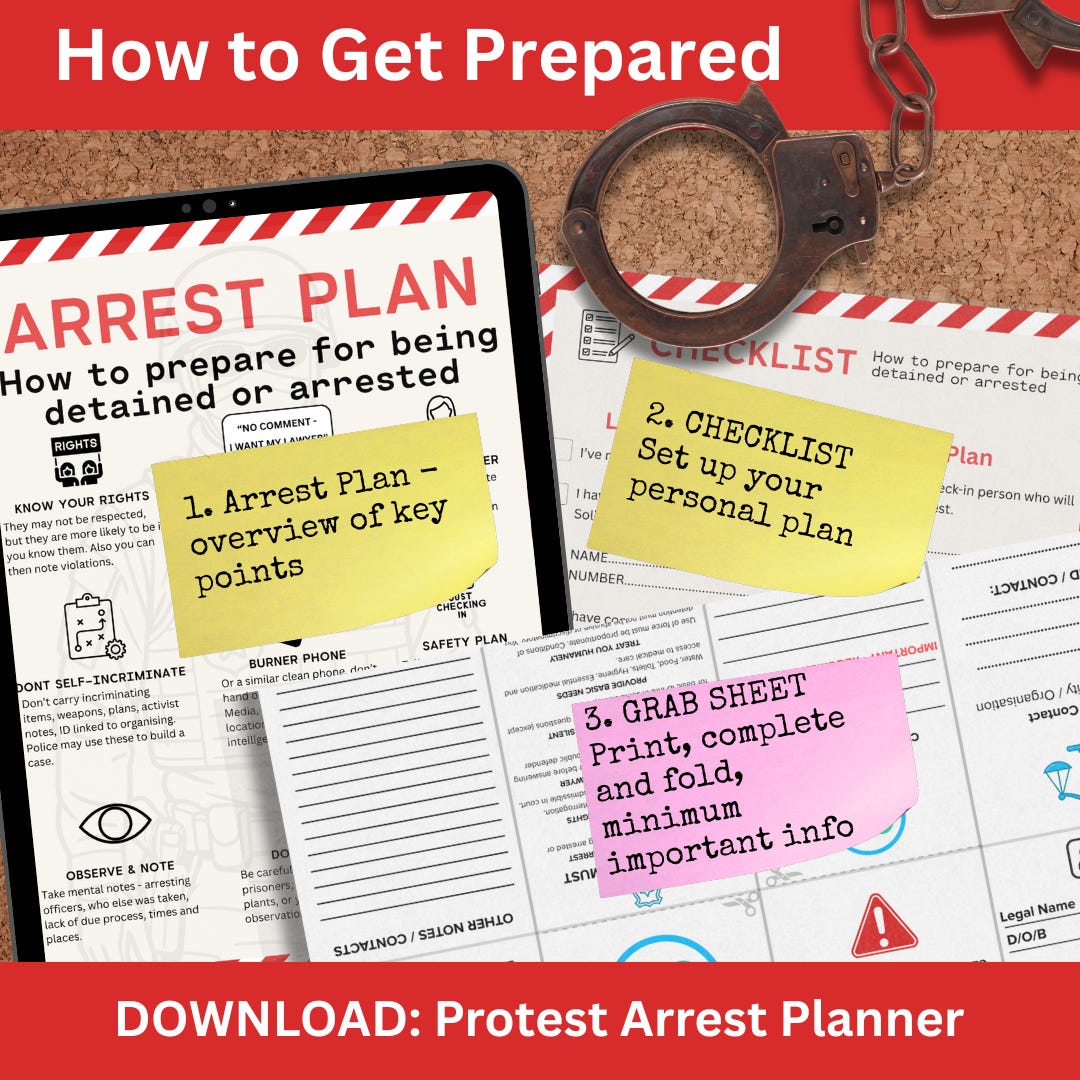You Need To Know How To Spot Fake Feds
Reports of kidnappings, killings, and assaults by individuals claiming to be police or federal agents have risen; here's six red flags you need to know.
1. Hiding their identity
Over 90% of U.S. police and federal agencies require officers to display insignia and identify themselves, except when undercover.
Clearly displaying, or providing when asked things like
Rank
Name
Number
Agency/Dept
ID
If someone claims to be a government agent but can’t or won’t provide that, alarm bells should start ringing. Look our for -
Note if individuals are wearing facemasks - especially non-medical ones. While masks can serve a protective function, the use of heavy-duty or tactical-style face coverings may be intended to obscure identity rather than prevent illness.
Are their eyes covered, even indoors or in low light? Dark tactical sunglasses worn in inappropriate conditions like at night or indoors may be a sign of someone trying to avoid identification.
2. A Lack of Due Process
Look out for these -
They do not inform people of their rights. If someone is being detained without a clear explanation of their rights — such as the right to remain silent or the right to legal counsel — this is a serious violation. The absence of a Miranda warning or equivalent should raise alarm.
They cannot or will not produce a proper warrant. Always ask to see any warrant. A valid judicial warrant should be signed by a judge and issued by a court. Be cautious of so-called 'administrative' warrants, which lack judicial authority and may be used to intimidate.
They refuse to state lawful grounds for stop, search, or detention. Everyone has the right to know why they are being stopped or held. Vague or evasive answers — or no explanation at all — should be treated with suspicion.
Detainees are denied access to basic rights. Withholding access to legal counsel, medical attention, water, or food is a violation of human rights and legal protections. Safe custody is a basic standard that should always be met.
They will not say where they are taking people. If individuals are being removed without explanation of their destination or without any record of the arrest, this is a major warning sign. In legal terms, this is an unlawful detention. In plain terms, it is kidnapping.
3. They are wearing unorthodox uniforms
Watch for excessive tactical gear worn without any identifying information. If an individual is fully kitted out in body armour or combat-style gear but lacks a visible name, badge number, or agency affiliation, that’s a potential red flag.
Be cautious of generic badges such as “FEDERAL” or “POLICE.” These can be bought online and do not necessarily confirm legitimate authority.
Look for inconsistencies within a group. Legitimate squads usually have matching uniforms and equipment. A mix of gear, colours, or insignia may suggest the group is not an official unit.
Unmarked vehicles or rentals are often used in grey-area operations. If a van or SUV involved in enforcement activities has no official plates or markings, question the legitimacy.
Generic tactical gear and insignia are easily available online. Body armour, patches, and vests resembling law enforcement kits can be bought by anyone — appearance alone doesn’t prove authority.
4. They are Camera-shy
They are not wearing body cameras. In the United States, the Department of Justice mandated body camera use for federal officers conducting pre-planned arrests, particularly when working alongside local agencies. If officers are operating without visible bodycams, this could indicate non-compliance or impersonation.
They are covering their faces unnecessarily. While masks may be worn for health or tactical reasons, face coverings that conceal identity without clear justification should be treated with suspicion.
They wear tactical sunglasses in inappropriate conditions. Dark eyewear worn indoors, at night, or in cloudy weather can be used to prevent identification and avoid eye contact — often a sign of concealed intent.
They attempt to stop filming. The right to record public officials, including police, is protected in many jurisdictions. Attempts to block filming, seize devices, or intimidate witnesses should be seen as a violation of public accountability.
They intimidate or assault witnesses. Use of force or threats against bystanders who are observing or documenting events is a serious abuse of power. Legitimate officers are trained to tolerate public scrutiny.
They threaten or obstruct the media. Journalists have a legal right to report on public events, including protests and arrests. Efforts to block or threaten members of the press may suggest that those in uniform do not want their actions documented.
5. They quickly resort to force
There is no attempt at de-escalation. Trained law enforcement officers are taught to defuse tension and resolve situations without violence wherever possible. If force is used immediately, without warning or negotiation, that is a major warning sign.
Force is used as a first resort, not the last. Legitimate agents are expected to use the minimum necessary force. If the situation is met with aggression from the outset, this may indicate they are not acting under lawful authority.
The force used is clearly excessive. Repeated strikes, chokeholds, or the use of weapons on non-violent individuals are signs of serious misconduct. Excessive force should never be accepted as routine.
Force is used without justification. If someone is being physically restrained, searched, or arrested without clear legal grounds, it is not only unlawful it is dangerous. Unjustified force often signals illegitimate or unauthorised action.
6. Tell the difference between abduction and arrest
There are reports of abductions in plain sight. Individuals including citizens, legal immigrants, students, and even children — have been taken from streets, homes, and workplaces by groups claiming to be law enforcement. These actions often occur without explanation or proper legal procedure.
People are imprisoned without charge. Detaining individuals without formally charging them is a direct violation of legal norms and due process. Everyone has the right to know what they are accused of.
They are held in undisclosed locations. If no one knows where someone is being taken or held, their safety is at serious risk. Detention in secret facilities is incompatible with the rule of law.
They are denied access to legal counsel. The right to a lawyer is a fundamental legal protection. If someone is not allowed to contact a solicitor or have legal representation, that is a clear breach of their rights.
They are not advised of their rights. Everyone has the right to be informed of their legal protections when detained. If this information is withheld or ignored, the detention is unlawful.
They are cut off from communication. Preventing individuals from contacting family, legal representatives, or the outside world is a tactic used to conceal abuses. This isolation increases the risk of mistreatment and disappearance.
STILL UNSURE?
It’s clear that there are two interlinked problems here, yes we are seeing people carrying out kidnappings and extortion without properly identifying themselves or following due process. The problem is only some of them are imposters, and it is the apparent disregard of the laws by supposedly official ICE agents that is encouraging, and facilitating the imposters.
Ultimately - if someone is seized by masked strangers and dissapeared, what is the difference if they are freelance or operating for the Fascist state?
So if someone ticks most of these red flags but turns out to be a “genuine” federal agent, then the problem isn't mistaken identity, it’s the collapse of democratic norms. A government that behaves like an impostor doesn’t deserve the benefit of the doubt.
If their actions are indistinguishable from those of unauthorised militias, kidnappers, or bad actors, it is reasonable to question their legitimacy. Authority must be accountable. Uniforms, badges, and jargon are not enough. Behaviour is what matters.
Know what to look for. Share our guides to educate others.
Download our free illustrated guide covering these six key red flags - identification, behaviour, equipment, communication, legal rights, and use of force — to help you recognise when something isn’t right. Because knowing what to expect could make all the difference.
DOWNLOADS
I’m offering two free downloads at the moment, but any donation, even $1, helps me keep creating content like this -
SIX RED FLAGS TO SPOT FAKE FEDS - FREE
HOW TO MAKE AN ARREST PLAN - FREE
EARLY WARNING SYSTEM - $2
Learn the nine tactical signs to spot that indicate Riot police are about to take action, charge, kettle, break up a crowd, or make an arrest.








